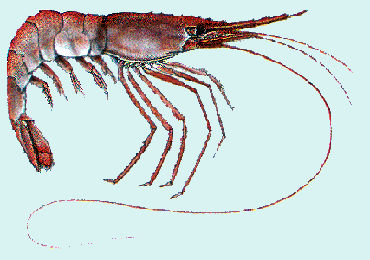Browse "Things"
-
Article
Shrew
Shrew (Soricidae), family of small insectivores represented today by approximately 250 species worldwide, 16 in Canada.
"https://development.thecanadianencyclopedia.ca/images/tce_placeholder.jpg?v=e9dca980c9bdb3aa11e832e7ea94f5d9" // resources/views/front/categories/view.blade.php
https://development.thecanadianencyclopedia.ca/images/tce_placeholder.jpg?v=e9dca980c9bdb3aa11e832e7ea94f5d9
-
"https://d2ttikhf7xbzbs.cloudfront.net/media/media/e34d15e4-77b7-4dd7-8f0f-2174ffa8e9e2.jpg" // resources/views/front/categories/view.blade.php
https://d2ttikhf7xbzbs.cloudfront.net/media/media/e34d15e4-77b7-4dd7-8f0f-2174ffa8e9e2.jpg
-
Article
Shrimp
Shrimp are decapods ("10-footed") crustacean, differing from other decapods in being adapted for swimming, a fact reflected in the large, laterally compressed abdomen and well-developed pairs of swimming legs.
"https://d2ttikhf7xbzbs.cloudfront.net/media/media/dfdc0d43-b713-4658-b7a0-23305d11e86b.jpg" // resources/views/front/categories/view.blade.php
https://d2ttikhf7xbzbs.cloudfront.net/media/media/dfdc0d43-b713-4658-b7a0-23305d11e86b.jpg
-
Article
SI Prefixes
SI Prefixes Factor Prefix Symbol 10¹ deca da 10² hecto h 10³ kilo k 106 mega M 109 giga G 1012 tera T 1015 peta P 1018 exa E 10-1 deci d 10-2 centi c 10-3 milli m 10-6 micro m 10-9 nano n 10-12 pico p 10-15 femto f 10-18 atto a For more information see the article WEIGHTS & MEASURES.
"https://development.thecanadianencyclopedia.ca/images/tce_placeholder.jpg?v=e9dca980c9bdb3aa11e832e7ea94f5d9" // resources/views/front/categories/view.blade.php
https://development.thecanadianencyclopedia.ca/images/tce_placeholder.jpg?v=e9dca980c9bdb3aa11e832e7ea94f5d9
-
Article
Sidbec-Dosco (Ispat) Inc
Sidbec-Dosco (Ispat) Inc, a wholly-owned subsidiary of Ispat International group, has its principal steel mill in CONTRECOEUR, and its head office in MONTRÉAL, Québec. Sidbec-Dosco is Canada's fourth largest steel producer.
"https://development.thecanadianencyclopedia.ca/images/tce_placeholder.jpg?v=e9dca980c9bdb3aa11e832e7ea94f5d9" // resources/views/front/categories/view.blade.php
https://development.thecanadianencyclopedia.ca/images/tce_placeholder.jpg?v=e9dca980c9bdb3aa11e832e7ea94f5d9
-
Article
Siege of Fort Erie, War of 1812
The siege of Fort Erie was a British blockade of their own fort located at the entrance to the Niagara River opposite Buffalo, New York, which the Americans had captured on 3 July 1814.
"https://development.thecanadianencyclopedia.ca/images/tce_placeholder.jpg?v=e9dca980c9bdb3aa11e832e7ea94f5d9" // resources/views/front/categories/view.blade.php
https://development.thecanadianencyclopedia.ca/images/tce_placeholder.jpg?v=e9dca980c9bdb3aa11e832e7ea94f5d9
-
Macleans
Sikh Editor Murdered
The sheer cowardice of the act was chilling. Someone, it appears, waited in the dusk that comes early this time of year for Tara Singh Hayer, the editor of North Americas largest Punjabi-language newspaper, to return to his home in Surrey, B.C., at the end of the workday on Nov. 18.This article was originally published in Maclean's Magazine on November 30, 1998
"https://development.thecanadianencyclopedia.ca/images/tce_placeholder.jpg?v=e9dca980c9bdb3aa11e832e7ea94f5d9" // resources/views/front/categories/view.blade.php
https://development.thecanadianencyclopedia.ca/images/tce_placeholder.jpg?v=e9dca980c9bdb3aa11e832e7ea94f5d9
-
Article
Sikhism in Canada
Sikhism, a major world religion, arose through the teachings of Guru Nanak (circa 1469–1539) in the Punjab region of India. There are about 27 million Sikhs worldwide, making Sikhism the fifth largest religion. Sikhs (disciple or "learner of truth"), like Jews, are distinguished both as a religion and as an ethnic group. Though in principle universalistic and open to converts regardless of background, Sikhism has been identified primarily with Punjabi people, events and culture. According to the 2021 Canadian census, 771,790 people reported being Sikh.
"https://d2ttikhf7xbzbs.cloudfront.net/media/media/e266d7b1-fb33-463e-96da-25996f85af41.jpg" // resources/views/front/categories/view.blade.php
https://d2ttikhf7xbzbs.cloudfront.net/media/media/e266d7b1-fb33-463e-96da-25996f85af41.jpg
-
Article
Siksikáí’powahsin: Blackfoot Language
Siksikáí’powahsin (commonly referred to as the Blackfoot language) is an Algonquian language spoken by four Blackfoot nations: the Siksiká (Blackfoot), Aapátohsipikani (North Piikani), Aamsskáápipikani (South Piikani) and Kainai (Blood). While there are some dialectal differences between these groups, speakers can generally understand one another. Blackfoot is an endangered language; since the 1960s, the number of new speakers has significantly decreased. The development of language programs and resources in Canada and the United States seek to preserve the language and promote it to new speakers.
"https://d2ttikhf7xbzbs.cloudfront.net/media/media/48719197-b6cd-42c6-ae22-4978290d2f26.jpg" // resources/views/front/categories/view.blade.php
https://d2ttikhf7xbzbs.cloudfront.net/media/media/48719197-b6cd-42c6-ae22-4978290d2f26.jpg
-
Article
Silica
Silica, or silicon dioxide (SiO2), occurs as the MINERAL quartz and is the most abundant mineral of the Earth's crust. It also occurs in the skeletal parts of some animals (eg, certain protozoa) and various plants.
"https://development.thecanadianencyclopedia.ca/images/tce_placeholder.jpg?v=e9dca980c9bdb3aa11e832e7ea94f5d9" // resources/views/front/categories/view.blade.php
https://development.thecanadianencyclopedia.ca/images/tce_placeholder.jpg?v=e9dca980c9bdb3aa11e832e7ea94f5d9
-
Article
Silver
Important producing countries now are Mexico, Peru, the Commonwealth of Independent States, the US, Canada, Australia, Chile, Poland and China. Photographic films and papers account for about 25% of the demand for silver.
"https://d2ttikhf7xbzbs.cloudfront.net/media/media/e53f0267-a935-463b-b0cf-e1995d2548ca.jpg" // resources/views/front/categories/view.blade.php
https://d2ttikhf7xbzbs.cloudfront.net/media/media/e53f0267-a935-463b-b0cf-e1995d2548ca.jpg
-
Article
Silver Dart
The Silver Dart is recognized as the first powered, heavier-than-air machine to fly in Canada. J.A.D. McCurdy successfully piloted the aircraft from Baddeck Bay, Nova Scotia on 23 February 1909. (See also Canadian Innovations in Aviation.)
"https://d2ttikhf7xbzbs.cloudfront.net/Aviation/silverdart.jpg" // resources/views/front/categories/view.blade.php
https://d2ttikhf7xbzbs.cloudfront.net/Aviation/silverdart.jpg
-
Editorial
The Silver Dart and the Dawn of Flight in Canada
The following article is an editorial written by The Canadian Encyclopedia staff. Editorials are not usually updated.
"https://d2ttikhf7xbzbs.cloudfront.net/media/media/f5702375-312b-424c-979a-442def6a6446.jpg" // resources/views/front/categories/view.blade.php
https://d2ttikhf7xbzbs.cloudfront.net/media/media/f5702375-312b-424c-979a-442def6a6446.jpg
-
Article
Silviculture
Silviculture is the branch of FORESTRY that deals with establishing, caring for and reproducing stands of trees for a variety of forest uses including wildlife habitat, timber production and outdoor recreation.
"https://development.thecanadianencyclopedia.ca/images/tce_placeholder.jpg?v=e9dca980c9bdb3aa11e832e7ea94f5d9" // resources/views/front/categories/view.blade.php
https://development.thecanadianencyclopedia.ca/images/tce_placeholder.jpg?v=e9dca980c9bdb3aa11e832e7ea94f5d9
-
Article
Siminovitch Prize
The Siminovitch Prize acknowledges artistic excellence in Canadian theatre. It is Canada’s largest theatre arts award. Also called the Elinore and Lou Siminovitch Prize in Theatre, it was established in honour of playwright Elinore Siminovitch and her husband, the renowned geneticist and medical scientist Louis Siminovitch. It was created in 2001 and is awarded annually to a playwright, director or designer. The prize is valued at $100,000 and is unique in its emphasis on mentorship; a total of $25,000 is shared with up to two theatre protégés of the recipient’s choosing.
"https://d2ttikhf7xbzbs.cloudfront.net/media/media/2f6933e1-296c-4f38-be39-cd027db2fdb1.jpg" // resources/views/front/categories/view.blade.php
https://d2ttikhf7xbzbs.cloudfront.net/media/media/2f6933e1-296c-4f38-be39-cd027db2fdb1.jpg
